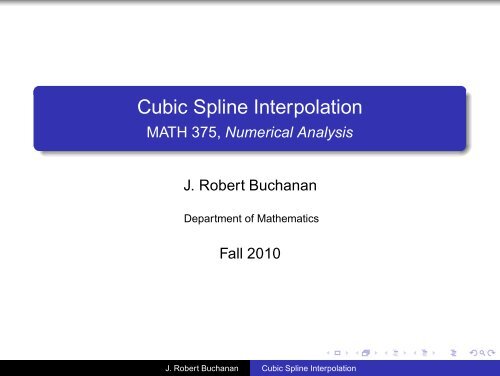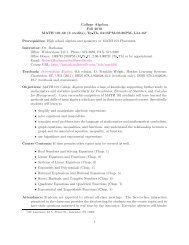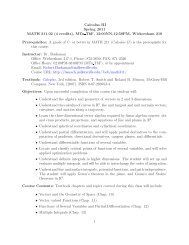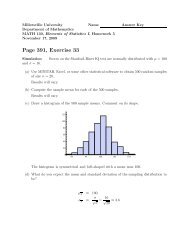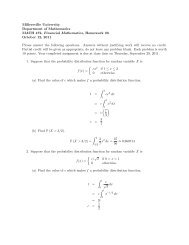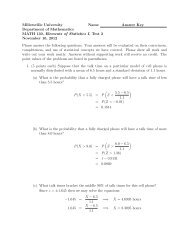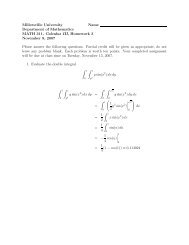Cubic Spline Interpolation - MATH 375, Numerical Analysis
Cubic Spline Interpolation - MATH 375, Numerical Analysis
Cubic Spline Interpolation - MATH 375, Numerical Analysis
You also want an ePaper? Increase the reach of your titles
YUMPU automatically turns print PDFs into web optimized ePapers that Google loves.
<strong>Cubic</strong> <strong>Spline</strong> <strong>Interpolation</strong><br />
<strong>MATH</strong> <strong>375</strong>, <strong>Numerical</strong> <strong>Analysis</strong><br />
J. Robert Buchanan<br />
Department of Mathematics<br />
Fall 2010<br />
J. Robert Buchanan <strong>Cubic</strong> <strong>Spline</strong> <strong>Interpolation</strong>
History<br />
Given nodes and data {(x0, f(x0)),(x1, f(x1)),... ,(xn, f(xn))}<br />
we have interpolated using:<br />
Lagrange interpolating polynomial of degree n, with n + 1<br />
coefficients,<br />
unfortunately,<br />
J. Robert Buchanan <strong>Cubic</strong> <strong>Spline</strong> <strong>Interpolation</strong>
History<br />
Given nodes and data {(x0, f(x0)),(x1, f(x1)),... ,(xn, f(xn))}<br />
we have interpolated using:<br />
Lagrange interpolating polynomial of degree n, with n + 1<br />
coefficients,<br />
unfortunately,<br />
such polynomials can possess large oscillations, and<br />
the error term can be difficult to construct and estimate.<br />
J. Robert Buchanan <strong>Cubic</strong> <strong>Spline</strong> <strong>Interpolation</strong>
History<br />
Given nodes and data {(x0, f(x0)),(x1, f(x1)),... ,(xn, f(xn))}<br />
we have interpolated using:<br />
Lagrange interpolating polynomial of degree n, with n + 1<br />
coefficients,<br />
unfortunately,<br />
such polynomials can possess large oscillations, and<br />
the error term can be difficult to construct and estimate.<br />
An alternative is piecewise polynomial approximation, but of<br />
what degree polynomial?<br />
J. Robert Buchanan <strong>Cubic</strong> <strong>Spline</strong> <strong>Interpolation</strong>
History<br />
Given nodes and data {(x0, f(x0)),(x1, f(x1)),... ,(xn, f(xn))}<br />
we have interpolated using:<br />
Lagrange interpolating polynomial of degree n, with n + 1<br />
coefficients,<br />
unfortunately,<br />
such polynomials can possess large oscillations, and<br />
the error term can be difficult to construct and estimate.<br />
An alternative is piecewise polynomial approximation, but of<br />
what degree polynomial?<br />
Piecewise linear results are not differentiable at xi,<br />
i = 0, 1,...,n.<br />
Piecewise quadratic results are not twice differentiable at<br />
xi, i = 0, 1,...,n.<br />
Piecewise cubic!<br />
J. Robert Buchanan <strong>Cubic</strong> <strong>Spline</strong> <strong>Interpolation</strong>
<strong>Cubic</strong> <strong>Spline</strong>s<br />
A cubic polynomial p(x) = a + bx + cx 2 + dx 3 is specified<br />
by 4 coefficients.<br />
The cubic spline is twice continuously differentiable.<br />
The cubic spline has the flexibility to satisfy general types<br />
of boundary conditions.<br />
While the spline may agree with f(x) at the nodes, we<br />
cannot guarantee the derivatives of the spline agree with<br />
the derivatives of f .<br />
J. Robert Buchanan <strong>Cubic</strong> <strong>Spline</strong> <strong>Interpolation</strong>
<strong>Cubic</strong> <strong>Spline</strong> Interpolant<br />
Given a function f(x) defined on [a, b] and a set of nodes<br />
a = x0 < x1 < x2 < · · · < xn = b,<br />
a cubic spline interpolant, S, for f satisfies<br />
S is a cubic polynomial, Sj on [xj, xj+1] for<br />
j = 0, 1,...,n − 1.<br />
S(xj) = f(xj) for j = 0, 1,... , n.<br />
Sj+1(xj+1) = Sj(xj+1) for j = 0, 1,...,n − 2.<br />
S ′ j+1 (xj+1) = S ′ j (xj+1) for j = 0, 1,...,n − 2.<br />
S ′′<br />
j+1 (xj+1) = S ′′<br />
j (xj+1) for j = 0, 1,...,n − 2.<br />
One of the following boundary conditions (BCs) is satisfied:<br />
S ′′ (x0) = S ′′ (xn) = 0 (free or natural BCs).<br />
S ′ (x0) = f ′ (x0) and S ′ (xn) = f ′ (xn) (clamped BCs).<br />
J. Robert Buchanan <strong>Cubic</strong> <strong>Spline</strong> <strong>Interpolation</strong>
Example (1 of 7)<br />
Construct a piecewise cubic spline interpolant for the curve<br />
passing through<br />
{(5, 5), (7, 2), (9, 4)},<br />
with natural boundary conditions.<br />
y<br />
6<br />
5<br />
4<br />
3<br />
2<br />
1<br />
4 5 6 7 8 9 10 x<br />
J. Robert Buchanan <strong>Cubic</strong> <strong>Spline</strong> <strong>Interpolation</strong>
Example (2 of 7)<br />
This will require two cubics:<br />
S0(x) = a0 + b0(x − 5) + c0(x − 5) 2 + d0(x − 5) 3<br />
S1(x) = a1 + b1(x − 7) + c1(x − 7) 2 + d1(x − 7) 3<br />
Since there are 8 coefficients, we must derive 8 equations to<br />
solve.<br />
J. Robert Buchanan <strong>Cubic</strong> <strong>Spline</strong> <strong>Interpolation</strong>
Example (2 of 7)<br />
This will require two cubics:<br />
S0(x) = a0 + b0(x − 5) + c0(x − 5) 2 + d0(x − 5) 3<br />
S1(x) = a1 + b1(x − 7) + c1(x − 7) 2 + d1(x − 7) 3<br />
Since there are 8 coefficients, we must derive 8 equations to<br />
solve.<br />
The splines must agree with the function (the y-coordinates) at<br />
the nodes (the x-coordinates).<br />
5 = S0(5) = a0<br />
2 = S0(7) = a0 + 2b0 + 4c0 + 8d0<br />
2 = S1(7) = a1<br />
4 = S1(9) = a1 + 2b1 + 4c1 + 8d1<br />
J. Robert Buchanan <strong>Cubic</strong> <strong>Spline</strong> <strong>Interpolation</strong>
Example (3 of 7)<br />
The first and second derivatives of the cubics must agree at<br />
their shared node x = 7.<br />
S ′ 0 (7) = b0 + 4c0 + 12d0 = b1 = S ′ 1 (7)<br />
S ′′<br />
0 (7) = 2c0 + 12d0 = 2c1 = S ′′<br />
1 (7)<br />
J. Robert Buchanan <strong>Cubic</strong> <strong>Spline</strong> <strong>Interpolation</strong>
Example (3 of 7)<br />
The first and second derivatives of the cubics must agree at<br />
their shared node x = 7.<br />
S ′ 0 (7) = b0 + 4c0 + 12d0 = b1 = S ′ 1 (7)<br />
S ′′<br />
0 (7) = 2c0 + 12d0 = 2c1 = S ′′<br />
1 (7)<br />
The final two equations come from the natural boundary<br />
conditions.<br />
S ′′<br />
0 (5) = 0 = 2c0<br />
S ′′<br />
1 (9) = 0 = 2c1 + 12d1<br />
J. Robert Buchanan <strong>Cubic</strong> <strong>Spline</strong> <strong>Interpolation</strong>
Example (4 of 7)<br />
All eight linear equations together form the system:<br />
5 = a0<br />
2 = a0 + 2b0 + 4c0 + 8d0<br />
2 = a1<br />
4 = a1 + 2b1 + 4c1 + 8d1<br />
0 = b0 + 4c0 + 12d0 − b1<br />
0 = 2c0 + 12d0 − 2c1<br />
0 = 2c0<br />
0 = 2c1 + 12d1<br />
J. Robert Buchanan <strong>Cubic</strong> <strong>Spline</strong> <strong>Interpolation</strong>
Example (5 of 7)<br />
The solution is:<br />
i ai bi ci di<br />
0 5 − 17<br />
8<br />
1 2 − 1<br />
4<br />
0<br />
15<br />
16<br />
5<br />
32<br />
− 5<br />
32<br />
J. Robert Buchanan <strong>Cubic</strong> <strong>Spline</strong> <strong>Interpolation</strong>
Example (6 of 7)<br />
The natural cubic spline can be expressed as:<br />
⎧<br />
⎪⎨<br />
5 −<br />
S(x) =<br />
⎪⎩<br />
17 5<br />
(x − 5) + (x − 5)3<br />
8 32<br />
2 − 1 15<br />
(x − 7) +<br />
4 16 (x − 7)2 − 5<br />
(x − 7)3<br />
32<br />
y<br />
6<br />
5<br />
4<br />
3<br />
2<br />
1<br />
4 5 6 7 8 9 10 x<br />
J. Robert Buchanan <strong>Cubic</strong> <strong>Spline</strong> <strong>Interpolation</strong><br />
if 5 ≤ x ≤ 7<br />
if 7 ≤ x ≤ 9
Example (7 of 7)<br />
We can verify the continuity of the first and second derivatives<br />
from the following graphs.<br />
1.5<br />
1.0<br />
0.5<br />
0.5<br />
1.0<br />
1.5<br />
2.0<br />
S'x<br />
6 7 8 9<br />
x<br />
S''x<br />
J. Robert Buchanan <strong>Cubic</strong> <strong>Spline</strong> <strong>Interpolation</strong><br />
1.5<br />
1.0<br />
0.5<br />
6 7 8 9<br />
x
General Construction Process<br />
Given n + 1 nodal/data values:<br />
{(x0, f(x0)),(x1, f(x1)),... ,(xn, f(xn))} we will create n cubic<br />
polynomials.<br />
J. Robert Buchanan <strong>Cubic</strong> <strong>Spline</strong> <strong>Interpolation</strong>
General Construction Process<br />
Given n + 1 nodal/data values:<br />
{(x0, f(x0)),(x1, f(x1)),... ,(xn, f(xn))} we will create n cubic<br />
polynomials.<br />
For j = 0, 1,...,n − 1 assume<br />
Sj(x) = aj + bj(x − xj) + cj(x − xj) 2 + dj(x − xj) 3 .<br />
We must find aj, bj, cj and dj (a total of 4n unknowns) subject to<br />
the conditions specified in the definition.<br />
J. Robert Buchanan <strong>Cubic</strong> <strong>Spline</strong> <strong>Interpolation</strong>
General Construction Process<br />
Given n + 1 nodal/data values:<br />
{(x0, f(x0)),(x1, f(x1)),... ,(xn, f(xn))} we will create n cubic<br />
polynomials.<br />
For j = 0, 1,...,n − 1 assume<br />
Sj(x) = aj + bj(x − xj) + cj(x − xj) 2 + dj(x − xj) 3 .<br />
We must find aj, bj, cj and dj (a total of 4n unknowns) subject to<br />
the conditions specified in the definition.<br />
Let hj = xj+1 − xj then<br />
Sj(xj) = aj = f(xj)<br />
Sj+1(xj+1) = aj+1 = Sj(xj+1) = aj + bjhj + cjh 2 j + djh 3 j .<br />
So far we know aj for j = 0, 1,...,n − 1 and have n equations<br />
and 3n unknowns.<br />
J. Robert Buchanan <strong>Cubic</strong> <strong>Spline</strong> <strong>Interpolation</strong>
First Derivative<br />
The continuity of the first derivative at the nodal points<br />
produces n more equations.<br />
For j = 0, 1,...,n − 1 we have<br />
Thus<br />
S ′ j (x) = bj + 2cj(x − xj) + 3dj(x − xj) 2 .<br />
S ′ j (xj) = bj<br />
S ′ j+1 (xj+1) = bj+1 = S ′ j (xj+1) = bj + 2cjhj + 3djh 2 j<br />
Now we have 2n equations and 3n unknowns.<br />
J. Robert Buchanan <strong>Cubic</strong> <strong>Spline</strong> <strong>Interpolation</strong>
Second Derivative<br />
The continuity of the second derivative at the nodal points<br />
produces n more equations.<br />
For j = 0, 1,...,n − 1 we have<br />
Thus<br />
S ′′<br />
j (x) = 2cj + 6dj(x − xj).<br />
S ′′<br />
j (xj) = 2cj<br />
S ′′<br />
j+1 (xj+1) = 2cj+1 = S ′′<br />
j (xj+1) = 2cj + 6djhj<br />
Now we have 3n equations and 3n unknowns.<br />
J. Robert Buchanan <strong>Cubic</strong> <strong>Spline</strong> <strong>Interpolation</strong>
Summary of Equations<br />
For j = 0, 1,...,n − 1 we have<br />
aj+1 = aj + bjhj + cjh 2 j + djh 3 j<br />
bj+1 = bj + 2cjhj + 3djh 2 j<br />
cj+1 = cj + 3djhj.<br />
Note: The quantities aj and hj are known.<br />
J. Robert Buchanan <strong>Cubic</strong> <strong>Spline</strong> <strong>Interpolation</strong>
Summary of Equations<br />
For j = 0, 1,...,n − 1 we have<br />
aj+1 = aj + bjhj + cjh 2 j + djh 3 j<br />
bj+1 = bj + 2cjhj + 3djh 2 j<br />
cj+1 = cj + 3djhj.<br />
Note: The quantities aj and hj are known.<br />
Solve the third equation for dj and substitute into the other two<br />
equations.<br />
dj = cj+1 − cj<br />
3hj<br />
J. Robert Buchanan <strong>Cubic</strong> <strong>Spline</strong> <strong>Interpolation</strong>
Solving the Equations (1 of 3)<br />
aj+1 = aj + bjhj + cjh 2 j +<br />
<br />
cj+1 − cj<br />
3hj<br />
= aj + bjhj + h2 j<br />
3 (2cj + cj+1)<br />
<br />
cj+1 − cj<br />
bj+1 = bj + 2cjhj + 3<br />
h<br />
3hj<br />
2 j<br />
= bj + hj(cj + cj+1)<br />
J. Robert Buchanan <strong>Cubic</strong> <strong>Spline</strong> <strong>Interpolation</strong><br />
<br />
h 3 j
Solving the Equations (1 of 3)<br />
aj+1 = aj + bjhj + cjh 2 j +<br />
<br />
cj+1 − cj<br />
3hj<br />
= aj + bjhj + h2 j<br />
3 (2cj + cj+1)<br />
<br />
cj+1 − cj<br />
bj+1 = bj + 2cjhj + 3<br />
h<br />
3hj<br />
2 j<br />
= bj + hj(cj + cj+1)<br />
Solve the first equation for bj.<br />
bj = 1<br />
hj<br />
(aj+1 − aj) − hj<br />
3 (2cj + cj+1)<br />
J. Robert Buchanan <strong>Cubic</strong> <strong>Spline</strong> <strong>Interpolation</strong><br />
<br />
h 3 j
Solving the Equations (2 of 3)<br />
Replace index j by j − 1 to obtain<br />
bj−1 = 1<br />
hj−1<br />
(aj − aj−1) − hj−1<br />
3 (2cj−1 + cj).<br />
J. Robert Buchanan <strong>Cubic</strong> <strong>Spline</strong> <strong>Interpolation</strong>
Solving the Equations (2 of 3)<br />
Replace index j by j − 1 to obtain<br />
bj−1 = 1<br />
hj−1<br />
(aj − aj−1) − hj−1<br />
3 (2cj−1 + cj).<br />
We can also re-index the earlier equation<br />
to obtain<br />
bj+1 = bj + hj(cj + cj+1)<br />
bj = bj−1 + hj−1(cj−1 + cj).<br />
Substitute the equations for bj−1 and bj into the remaining<br />
equation.<br />
J. Robert Buchanan <strong>Cubic</strong> <strong>Spline</strong> <strong>Interpolation</strong>
Solving the Equations (3 of 3)<br />
1<br />
hj<br />
(aj+1 − aj) − hj<br />
3 (2cj + cj+1)<br />
=<br />
1<br />
hj−1<br />
(aj − aj−1) − hj−1<br />
3 (2cj−1 + cj) + hj−1(cj−1 + cj)<br />
Collect all terms involving c to one side.<br />
hj−1cj−1+2cj(hj−1+hj)+hjcj+1 = 3<br />
(aj+1 −aj)− 3<br />
for j = 1, 2,...,n − 1.<br />
hj<br />
J. Robert Buchanan <strong>Cubic</strong> <strong>Spline</strong> <strong>Interpolation</strong><br />
(aj −aj−1)<br />
hj−1
Solving the Equations (3 of 3)<br />
1<br />
hj<br />
(aj+1 − aj) − hj<br />
3 (2cj + cj+1)<br />
=<br />
1<br />
hj−1<br />
(aj − aj−1) − hj−1<br />
3 (2cj−1 + cj) + hj−1(cj−1 + cj)<br />
Collect all terms involving c to one side.<br />
hj−1cj−1+2cj(hj−1+hj)+hjcj+1 = 3<br />
(aj+1 −aj)− 3<br />
for j = 1, 2,...,n − 1.<br />
Remark: we have n − 1 equations and n + 1 unknowns.<br />
hj<br />
J. Robert Buchanan <strong>Cubic</strong> <strong>Spline</strong> <strong>Interpolation</strong><br />
(aj −aj−1)<br />
hj−1
Natural Boundary Conditions<br />
If S ′′ (x0) = S ′′<br />
0 (x0) = 2c0 = 0 then c0 = 0 and if<br />
S ′′ (xn) = S ′′<br />
n−1 (xn) = 2cn = 0 then cn = 0.<br />
J. Robert Buchanan <strong>Cubic</strong> <strong>Spline</strong> <strong>Interpolation</strong>
Natural Boundary Conditions<br />
If S ′′ (x0) = S ′′<br />
0 (x0) = 2c0 = 0 then c0 = 0 and if<br />
S ′′ (xn) = S ′′<br />
n−1 (xn) = 2cn = 0 then cn = 0.<br />
Theorem<br />
If f is defined at a = x0 < x1 < · · · < xn = b then f has a unique<br />
natural cubic spline interpolant.<br />
J. Robert Buchanan <strong>Cubic</strong> <strong>Spline</strong> <strong>Interpolation</strong>
Natural BC Linear System (1 of 2)<br />
In matrix form the system of n + 1 equations has the form<br />
Ac = y where<br />
⎡<br />
1 0 0 0 · · · 0<br />
⎤<br />
⎢ h0 ⎢ 0<br />
A = ⎢ .<br />
⎣ 0<br />
2(h0 + h1)<br />
h1<br />
.<br />
0<br />
h1<br />
2(h1 + h2)<br />
.<br />
0<br />
0<br />
h2<br />
.<br />
hn−2<br />
· · · 0 ⎥<br />
· · · 0 ⎥<br />
. ⎥<br />
2(hn−2 + hn−1) hn−1<br />
⎦<br />
0 0 0 0 · · · 1<br />
Note: A is a tridiagonal matrix.<br />
J. Robert Buchanan <strong>Cubic</strong> <strong>Spline</strong> <strong>Interpolation</strong>
Natural BC Linear System (2 of 2)<br />
⎡<br />
⎢<br />
A ⎢<br />
⎣<br />
c0<br />
c1<br />
c2<br />
.<br />
cn−1<br />
cn<br />
⎤<br />
⎡<br />
⎥ ⎢<br />
⎥ ⎢<br />
⎥ ⎢<br />
⎥ ⎢<br />
⎥ = ⎢<br />
⎥ ⎢<br />
⎥ ⎢<br />
⎦ ⎢<br />
⎣<br />
0<br />
3<br />
h (a2 − a1) −<br />
1 3<br />
h (a1 − a0)<br />
0<br />
3<br />
h (a3 − a2) −<br />
2 3<br />
h (a2 − a1)<br />
1<br />
.<br />
3<br />
h (an − an−1) −<br />
n−1 3<br />
h<br />
(an−1 − an−2)<br />
n−2<br />
0<br />
J. Robert Buchanan <strong>Cubic</strong> <strong>Spline</strong> <strong>Interpolation</strong><br />
⎤<br />
⎥<br />
⎦
Natural <strong>Cubic</strong> <strong>Spline</strong> Algorithm<br />
INPUT {(x0, f(x0)),(x1, f(x1)),... ,(xn, f(xn))}<br />
STEP 1 For i = 0, 1,...,n − 1 set ai = f(xi); set<br />
hi = xi+1 − xi.<br />
STEP 2 For i = 1, 2,...,n − 1 set<br />
αi = 3<br />
(ai+1 − ai) − 3<br />
(ai − ai−1).<br />
hi<br />
hi−1<br />
STEP 3 Set l0 = 1; set µ0 = 0; set z0 = 0.<br />
STEP 4 For i = 1, 2,...,n − 1 set<br />
li = 2(xi+1 − xi−1) − hi−1µi−1; set µi = hi<br />
li<br />
; set<br />
zi = αi − hi−1zi−1<br />
.<br />
li<br />
STEP 5 Set ln = 1; set cn = 0; set zn = 0.<br />
STEP 6 For j = n − 1, n − 2,... , 0 set cj = zj − µjcj+1; set<br />
bj = aj+1 − aj<br />
−<br />
hj<br />
hj(cj+1 + 2cj)<br />
; set dj =<br />
3<br />
cj+1 − cj<br />
.<br />
3hj<br />
STEP 7 For j = 0, 1,...,n − 1 OUTPUT aj, bj, cj, dj.<br />
J. Robert Buchanan <strong>Cubic</strong> <strong>Spline</strong> <strong>Interpolation</strong>
Example (1 of 4)<br />
Construct the natural cubic spline interpolant for<br />
f(x) = ln(e x + 2) with nodal values:<br />
x f(x)<br />
−1.0 0.86199480<br />
−0.5 0.95802009<br />
0.0 1.0986123<br />
0.5 1.2943767<br />
Calculate the absolute error in using the interpolant to<br />
approximate f(0.25) and f ′ (0.25).<br />
J. Robert Buchanan <strong>Cubic</strong> <strong>Spline</strong> <strong>Interpolation</strong>
Example (2 of 4)<br />
In this case n = 3 and<br />
with<br />
h0 = h1 = h2 = 0.5<br />
a0 = 0.86199480, a1 = 0.95802009,<br />
a2 = 1.0986123, a3 = 1.2943767.<br />
The linear system resembles,<br />
⎡<br />
1.0 0.0 0.0<br />
⎤⎡<br />
0.0<br />
⎢<br />
Ac = ⎢ 0.5<br />
⎣ 0.0<br />
2.0<br />
0.5<br />
0.5<br />
2.0<br />
0.0 ⎥⎢<br />
⎥⎢<br />
0.5 ⎦⎣<br />
0.0 0.0 0.0 1.0<br />
c0<br />
c1<br />
c2<br />
c3<br />
⎤<br />
⎥<br />
⎦ =<br />
⎡<br />
⎢<br />
⎣<br />
J. Robert Buchanan <strong>Cubic</strong> <strong>Spline</strong> <strong>Interpolation</strong><br />
0.0<br />
0.267402<br />
0.331034<br />
0.0<br />
⎤<br />
⎥<br />
⎦ = y
Example (3 of 4)<br />
The coefficients of the piecewise cubics:<br />
i ai bi ci di<br />
0 0.861995 0.175638 0.0 0.0656509<br />
1 0.95802 0.224876 0.0984763 0.028281<br />
2 1.09861 0.344563 0.140898 −0.093918<br />
J. Robert Buchanan <strong>Cubic</strong> <strong>Spline</strong> <strong>Interpolation</strong>
Example (3 of 4)<br />
The coefficients of the piecewise cubics:<br />
i ai bi ci di<br />
0 0.861995 0.175638 0.0 0.0656509<br />
1 0.95802 0.224876 0.0984763 0.028281<br />
2 1.09861 0.344563 0.140898 −0.093918<br />
The cubic spline:<br />
⎧<br />
⎪⎨<br />
S(x) =<br />
⎪⎩<br />
0.861995 + 0.175638(x + 1) if −1 ≤ x ≤ −0.5<br />
+ 0.0656509(x + 1) 2<br />
0.95802 + 0.224876(x + 0.5)<br />
+ 0.0984763(x + 0.5) 2 if −0.5 ≤ x ≤ 0<br />
+ 0.028281(x + 0.5) 3<br />
1.09861 + 0.344563x if 0 ≤ x ≤ 0.5<br />
+ 0.140898x 2 − 0.093918x 3<br />
J. Robert Buchanan <strong>Cubic</strong> <strong>Spline</strong> <strong>Interpolation</strong>
Example (4 of 4)<br />
1.0 0.8 0.6 0.4 0.2 0.2 0.4<br />
f(0.25) S(0.25) Abs. Err. f ′ (0.25) S ′ (0.25) Abs. Err.<br />
1.18907 1.19209 3.02154 × 10 −3 0.390991 0.3974 6.40839 × 10 −3<br />
y<br />
1.3<br />
1.2<br />
1.1<br />
1.0<br />
J. Robert Buchanan <strong>Cubic</strong> <strong>Spline</strong> <strong>Interpolation</strong><br />
x
Clamped Boundary Conditions (1 of 2)<br />
If S ′ (a) = S ′ 0 (a) = f ′ (a) = b0 then<br />
f ′ (a) = 1<br />
which is equivalent to<br />
h0<br />
(a1 − a0) − h0<br />
3 (2c0 + c1)<br />
h0(2c0 + c1) = 3<br />
(a1 − a0) − 3f ′ (a).<br />
h0<br />
J. Robert Buchanan <strong>Cubic</strong> <strong>Spline</strong> <strong>Interpolation</strong>
Clamped Boundary Conditions (2 of 2)<br />
Likewise if S ′ (b) = S ′ n(b) = f ′ (b) = bn then<br />
bn = bn−1 + hn−1(cn−1 + cn)<br />
=<br />
1<br />
(an − an−1) −<br />
hn−1<br />
hn−1<br />
3 (2cn−1 + cn) + hn−1(cn−1 + cn)<br />
=<br />
1<br />
(an − an−1) + hn−1<br />
3 (cn−1 + 2cn)<br />
hn−1<br />
which is equivalent to<br />
Theorem<br />
hn−1(cn−1 + 2cn) = 3f ′ (b) − 3<br />
hn−1<br />
(an − an−1).<br />
If f is defined at a = x0 < x1 < · · · < xn = b and differentiable at<br />
x = a and at x = b, then f has a unique clamped cubic spline<br />
interpolant.<br />
J. Robert Buchanan <strong>Cubic</strong> <strong>Spline</strong> <strong>Interpolation</strong>
Clamped BC Linear System (1 of 2)<br />
In matrix form the system of n + 1 equations has the form<br />
Ac = y where<br />
⎡<br />
2h0<br />
⎢ h0 ⎢ 0<br />
A = ⎢ .<br />
⎣ 0<br />
h0<br />
2(h0 + h1)<br />
h1<br />
.<br />
0<br />
0<br />
h1<br />
2(h1 + h2)<br />
.<br />
0<br />
0<br />
0<br />
h2<br />
.<br />
hn−2<br />
· · ·<br />
· · ·<br />
· · ·<br />
2(hn−2 + hn−1)<br />
0<br />
0<br />
0<br />
.<br />
hn−1<br />
⎤<br />
⎥<br />
⎦<br />
0 0 0 · · · hn−1 2hn−1<br />
Note: A is a tridiagonal matrix.<br />
J. Robert Buchanan <strong>Cubic</strong> <strong>Spline</strong> <strong>Interpolation</strong>
Clamped BC Linear System (2 of 2)<br />
⎡<br />
⎢<br />
A ⎢<br />
⎣<br />
c0<br />
c1<br />
c2<br />
.<br />
cn−1<br />
cn<br />
⎡<br />
⎤<br />
⎢<br />
⎥ ⎢<br />
⎥ ⎢<br />
⎥ ⎢<br />
⎥ ⎢<br />
⎥ = ⎢<br />
⎥ ⎢<br />
⎥ ⎢<br />
⎦ ⎢<br />
⎣<br />
3<br />
3<br />
h 0 (a1 − a0) − 3f ′ (a)<br />
h (a2 − a1) −<br />
1 3<br />
h (a1 − a0)<br />
0<br />
3<br />
h (a3 − a2) −<br />
2 3<br />
h (a2 − a1)<br />
1<br />
.<br />
3<br />
h (an − an−1) −<br />
n−1 3<br />
h<br />
(an−1 − an−2)<br />
n−2<br />
3f ′ (b) − 3<br />
h (an − an−1)<br />
n−1<br />
J. Robert Buchanan <strong>Cubic</strong> <strong>Spline</strong> <strong>Interpolation</strong><br />
⎤<br />
⎥<br />
⎦
Coefficients of the <strong>Cubic</strong> <strong>Spline</strong>s<br />
Since aj for j = 0, 1,...,n is known, once we solve the linear<br />
system for cj (again for j = 0, 1,...,n) then<br />
for j = 0, 1,...,n − 1.<br />
bj = 1<br />
(aj+1 − aj) −<br />
hj<br />
hj<br />
3 (cj+1 + 2cj) dj = 1<br />
(cj+1 − cj)<br />
3hj<br />
J. Robert Buchanan <strong>Cubic</strong> <strong>Spline</strong> <strong>Interpolation</strong>
Clamped <strong>Cubic</strong> <strong>Spline</strong> Algorithm (1 of 2)<br />
INPUT {(x0, f(x0)),(x1, f(x1)),... ,(xn, f(xn))}, f ′ (x0), and<br />
f ′ (xn).<br />
STEP 1 For i = 0, 1,...,n − 1 set ai = f(xi); set<br />
hi = xi+1 − xi.<br />
STEP 2 Set α0 = 3(a1 − a0)<br />
− 3f ′ (x0);<br />
h0<br />
αn = 3f ′ (xn) − 3(an − an−1)<br />
hn−1<br />
STEP 3 For i = 1, 2,...,n − 1 set<br />
αi = 3<br />
(ai+1 − ai) − 3<br />
(ai − ai−1).<br />
hi<br />
hi−1<br />
STEP 4 Set l0 = 2h0; µ0 = 0.5; z0 = α0<br />
J. Robert Buchanan <strong>Cubic</strong> <strong>Spline</strong> <strong>Interpolation</strong><br />
.<br />
l0<br />
.
Clamped <strong>Cubic</strong> <strong>Spline</strong> Algorithm (2 of 2)<br />
STEP 5 For i = 1, 2,...,n − 1 set<br />
li = 2(xi+1 − xi−1) − hi−1µi−1; µi = hi<br />
zi = αi − hi−1zi−1<br />
.<br />
li<br />
STEP 6 Set ln = hn−1(2 − µn−1); zn = αn − hn−1zn−1<br />
cn = zn.<br />
STEP 7 For j = n − 1, n − 2,... , 0 set cj = zj − µjcj+1;<br />
bj = aj+1 − aj<br />
hj<br />
− hj(cj+1 + 2cj)<br />
3<br />
li<br />
;<br />
ln<br />
; dj = cj+1 − cj<br />
.<br />
3hj<br />
STEP 8 For j = 0, 1,...,n − 1 OUTPUT aj, bj, cj, dj.<br />
J. Robert Buchanan <strong>Cubic</strong> <strong>Spline</strong> <strong>Interpolation</strong><br />
;
Example (1 of 4)<br />
Construct the clamped cubic spline interpolant for<br />
f(x) = ln(e x + 2) with nodal values:<br />
x f(x)<br />
−1.0 0.86199480<br />
−0.5 0.95802009<br />
0.0 1.0986123<br />
0.5 1.2943767<br />
Calculate the absolute error in using the interpolant to<br />
approximate f(0.25) and f ′ (0.25).<br />
J. Robert Buchanan <strong>Cubic</strong> <strong>Spline</strong> <strong>Interpolation</strong>
Example (2 of 4)<br />
In this case n = 3 and<br />
with<br />
h0 = h1 = h2 = 0.5<br />
a0 = 0.86199480, a1 = 0.95802009,<br />
a2 = 1.0986123, a3 = 1.2943767.<br />
Note that f ′ (−1) ≈ 0.155362 and f ′ (0.5) ≈ 0.451863.<br />
The linear system resembles,<br />
⎡<br />
1.0 0.5 0.0<br />
⎤ ⎡<br />
0.0<br />
⎢<br />
Ac = ⎢ 0.5<br />
⎣ 0.0<br />
2.0<br />
0.5<br />
0.5<br />
2.0<br />
0.0 ⎥ ⎢<br />
⎥ ⎢<br />
0.5 ⎦ ⎣<br />
0.0 0.0 0.5 1.0<br />
c0<br />
c1<br />
c2<br />
c3<br />
⎤<br />
⎥<br />
⎦ =<br />
⎡<br />
⎢<br />
⎣<br />
J. Robert Buchanan <strong>Cubic</strong> <strong>Spline</strong> <strong>Interpolation</strong><br />
0.110064<br />
0.267402<br />
0.331034<br />
0.181001<br />
⎤<br />
⎥<br />
⎦ = y.
Example (3 of 4)<br />
The coefficients of the piecewise cubics:<br />
i a i b i c i d i<br />
0 0.861995 0.155362 0.0653748 0.0160031<br />
1 0.95802 0.23274 0.0893795 0.0150207<br />
2 1.09861 0.333384 0.11191 0.00875717<br />
J. Robert Buchanan <strong>Cubic</strong> <strong>Spline</strong> <strong>Interpolation</strong>
Example (3 of 4)<br />
The coefficients of the piecewise cubics:<br />
i a i b i c i d i<br />
0 0.861995 0.155362 0.0653748 0.0160031<br />
1 0.95802 0.23274 0.0893795 0.0150207<br />
2 1.09861 0.333384 0.11191 0.00875717<br />
The cubic spline:<br />
⎧<br />
⎪⎨<br />
S(x) =<br />
⎪⎩<br />
0.861995 + 0.155362(x + 1)<br />
+ 0.0653748(x + 1) 2 if −1 ≤ x ≤ −0.5<br />
+ 0.0160031(x + 1) 3<br />
0.95802 + 0.23274(x + 0.5)<br />
+ 0.0893795(x + 0.5) 2 if −0.5 ≤ x ≤ 0<br />
+ 0.0150207(x + 0.5) 3<br />
1.09861 + 0.333384x + 0.11191x 2 if 0 ≤ x ≤ 0.5<br />
+ 0.00875717x 3<br />
J. Robert Buchanan <strong>Cubic</strong> <strong>Spline</strong> <strong>Interpolation</strong>
Example (4 of 4)<br />
1.0 0.8 0.6 0.4 0.2 0.2 0.4<br />
f(0.25) S(0.25) Abs. Err. f ′ (0.25) S ′ (0.25) Abs. Err.<br />
1.18907 1.18991 1.97037 × 10 −5 0.390991 0.390982 9.67677 × 10 −6<br />
y<br />
1.3<br />
1.2<br />
1.1<br />
1.0<br />
J. Robert Buchanan <strong>Cubic</strong> <strong>Spline</strong> <strong>Interpolation</strong><br />
x
Error <strong>Analysis</strong><br />
Theorem<br />
Let f ∈ C 4 [a, b] with max<br />
a≤x≤b<br />
<br />
<br />
f (4) <br />
<br />
(x) = M. If S is the unique<br />
clamped cubic spline interpolant to f with respect to nodes<br />
a = x0 < x1 < · · · < xn = b, then for all x ∈ [a, b],<br />
|f(x) − S(x)| ≤ 5M<br />
384 max<br />
0≤j≤n−1 (xj+1 − xj) 4 .<br />
J. Robert Buchanan <strong>Cubic</strong> <strong>Spline</strong> <strong>Interpolation</strong>
Example<br />
Earlier we found the clamped cubic spline interpolant for<br />
f(x) = ln(e x + 2). In this example xj+1 − xj = 0.5 for all j.<br />
Note that<br />
max<br />
−1≤x≤0.5<br />
f (4) (x) = 2ex (4 − 8e x + e 2x )<br />
(2 + ex ) 4<br />
<br />
<br />
f (4) <br />
<br />
(x) ≈ 0.120398<br />
|f(0.25) − S(0.25)| = 1.97037 × 10 −5<br />
≤ 5(0.120398)<br />
384<br />
≈ 9.798 × 10 −5 .<br />
J. Robert Buchanan <strong>Cubic</strong> <strong>Spline</strong> <strong>Interpolation</strong><br />
(0.5) 4
Natural <strong>Cubic</strong> <strong>Spline</strong> Example (1 of 2)<br />
Consider the following data:<br />
x f(x)<br />
−0.5 −0.02475<br />
−0.25 0.334938<br />
0.0 1.101<br />
The coefficients of the natural cubic spline interpolant are<br />
a b c d<br />
−0.02475 1.03238 0.0 6.502<br />
0.334938 2.2515 4.8765 −6.502<br />
J. Robert Buchanan <strong>Cubic</strong> <strong>Spline</strong> <strong>Interpolation</strong>
Natural <strong>Cubic</strong> <strong>Spline</strong> Example (2 of 2)<br />
-0.5 -0.4 -0.3 -0.2 -0.1<br />
J. Robert Buchanan <strong>Cubic</strong> <strong>Spline</strong> <strong>Interpolation</strong><br />
fx<br />
1<br />
0.8<br />
0.6<br />
0.4<br />
0.2<br />
x
Clamped <strong>Cubic</strong> <strong>Spline</strong> Example (1 of 3)<br />
Here we will find the clamped cubic spline interpolant to the<br />
function f(x) = J0( √ x) at the nodes xi = 5i for i = 0, 1,...,10.<br />
x f(x)<br />
0.0 1.0<br />
5.0 0.0904053<br />
10.0 −0.310045<br />
. .<br />
50.0 0.299655<br />
Note: f ′ (0) = −0.25 and f ′ (50) = −0.00117217.<br />
J. Robert Buchanan <strong>Cubic</strong> <strong>Spline</strong> <strong>Interpolation</strong>
Clamped <strong>Cubic</strong> <strong>Spline</strong> Example (2 of 3)<br />
The coefficients of the clamped cubic spline interpolant are<br />
a b c d<br />
1 −0.25 0.0154655 −0.00036986<br />
0.09040533 −0.1230843 0.009917643 −0.00026<strong>375</strong>77<br />
−0.3100448 −0.0436897 0.005961278 −0.0001836499<br />
−0.4024176 0.00214934 0.003206529 −0.0001229411<br />
−0.3268753 0.02499404 0.001362412 −0.0000780158<br />
−0.1775968 0.03276697 0.000192174 −0.0000454083<br />
−0.0146336 0.03128308 −0.00048895 −0.0000224102<br />
0.12675676 0.02471281 −0.00082510 −6.79522E − 06<br />
0.22884382 0.01595213 −0.00092703 3.265389E − 06<br />
0.28583684 0.00692671 −0.00087805 9.088463E − 06<br />
J. Robert Buchanan <strong>Cubic</strong> <strong>Spline</strong> <strong>Interpolation</strong>
Clamped <strong>Cubic</strong> <strong>Spline</strong> Example (3 of 3)<br />
1.0<br />
0.8<br />
0.6<br />
0.4<br />
0.2<br />
0.2<br />
0.4<br />
y<br />
10 20 30 40 50 x<br />
J. Robert Buchanan <strong>Cubic</strong> <strong>Spline</strong> <strong>Interpolation</strong>
Homework<br />
Read Section 3.5<br />
Exercises: 1, 3d, 5d, 7d, 31<br />
J. Robert Buchanan <strong>Cubic</strong> <strong>Spline</strong> <strong>Interpolation</strong>


